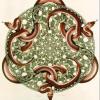There seems to be quite a bit of confusion about BPC157 therefore lets try to make it clear once for all.
Because of several reasons this compound is studied only by relatively small groups of researchers likely on a quite low budget, we all whish to see all kind of possible researches and data but unfortunately that's not the reality we have to face, therefore just don't expect to get ALL the answers you wish for.
In the late '80s a group of researchers from now ex-Yugoslavia discovered BPC as a gastric juice component.
"Until now the gastrointestinal tract, especially stomach, was considered only as a target organ for stress. There was never discussed the possibility that gastrointestinal tract, preferably the stomach, may be the organ which can initiate the defensive response of the whole organism. This response, actually directed against stress, must be realized in the formation and release of a new endogenous agent. Our attempt was directed to isolate this agent from stomach juice. Finally we isolated the expected substance from the stomach juice of 542 patients. This substance was nominated with abbreviation BPC which means: Body Protection Compound.
The structure of this substance is very complex and after our investigation until now can be characterized as folded protein with partial sequence from N-terminus:
H2 N-Gly-Glu-Pro-Pro-Pro-Gly-Lys-Pro-Ala-Asp-Asp-Ala-Gly-Leu-Val- . . . --COOH"
https://www.google.c...tents/US5288708
In the following years the same researchers worked on a synthetic BPC form which was more stable and in '98 found that just a portion of the peptides chain was enough to retain the healing and protective proprieties.
"Pentadecapeptide BPC 157 or bepecin (abbr. for: Body Protecting Compound) has the following peptide sequence: Gly Glu Pro Pro Pro Gly Lys Pro Ala Asp Asp Ala Gly Leu Val and represents the N-terminal part of a natural BPC protein which is actually present in the gastric juice of mammals. The natural BPC protein is obtained from human or animal gastric juice by means of complicated biochemical methods (U. S. Patent No. 5,288,708). Irrespective of demanding work this way of obtaining is inappropriate also with regard to an uncertain source of raw material and a possible contamination with viruses. Therefore, by chemical synthesis (P. Sikiric, . Rucman, B. Rucman, M. Petek, Peptides 1998, Proceed, of 25th EPS, Budapest 1998, p. 814; Z. Pflaum and R. Rucman, Acta Chim. Slov., 2005, 52, 34-39) only the N-terminal part with the above stated sequence has been prepared. Surprisingly, it has been found that this fragment retained practically all effects of the natural BPC protein (EP 0572688 and U. S. Patent No. 6,268,346). The N-terminal part with a sequence of 15 amino acids seems to be the most responsible for the biological activity of the entire protein. The compound is very interesting from a medical point of view, as it has effect to almost all organs at extremely low concentrations (in a range from ng to mg and more per a kilogram of body weight) and without any toxic or side effects."
https://www.google.c...4142764A1?cl=en
In other words BPC as we know it was born, a sequence of 15 peptides.
Now, what is stable or not might cause confusion, peptides stability vary according to their structure.
http://www.sigmaaldr...-stability.html
Stability doesn't have a measure unit, there are several parameters to keep in consideration, itself the word "stable" means very little, it would be like stating I am tall, how tall?
At 1,70m I would be really tall compared to a dwarf but a Lilliputian compared to a NBL basket player, woudn't I?
Therefore when talking about how stable a peptide is we are referring at its stability compared to.
Synthetic pentadecapeptide (which means made of 15 peptides) BPC157 is more stable than its organic counterpart from gastric juice.
The salt form of it is more stable than the acetate form.
"Table 1. Pentadecapeptide content decrement in standing at 50 °C and relat. humidity 65 %:
Substance: 0 day 10 davs 30 davs 60 davs 90 davs
BPC acetate 99.65 % 95.97 % 91.98 % 85.49 % 85.90 %
BPC Na salt 99.20 % 97.22 % 96,46 % 97.38 % 97.14 %
Table 2. Pentadecapeptide content decrement in water at 50 °C / time (hours):
Substance: pH start/0 20 65 148 388
BPC acetate 3.88 98.89 % 71.17 % 55.25 % 52.55 % ' 21.30 %
BPC Na-salt 8.42 99.01 % 98.36 % 97.47 % N.D. 96.74 %
Table 3. Pentadecapeptide content decrement in water at 100 °C - 1 hour:
Substance: start after 1 hour
BPC acetate 98.89 % 56.80 %
BPC Na-salt 99.01 % 98.56 %
Table 4. Pentadecapeptide content decrement (rel. %) in gastric juice at pH = 2.0
Substance: Time (hours):
0 0.5 1.0 1.5 2.0 2.5
BPC acetate 100 21.4 8.2 4.75 2.46 2.1
BPC Na-salt 100 21.6 6.7 4.4 4.2 2.7
Table 5. Pentadecapeptide content decrement (rel. %) in gastric juice at pH = 3.0
Substance: Time (hours):
0 0.5 1.0 2.0 3.0 4.0 5.0
BPC acetate 100 41.7 26.1 7.8 2.5 1.1 0.08
BPC Na-salt 100 81.9 71.6 56.0 40.2 29.7 10.1
Table 6. Pentadecapeptide content decrement (rel. %) in gastric juice at pH = 4.0
Substance: Time (hours):
0 1 2 3 4 5 6 7 8
BPC acetate 100 89.7 81.3 72.5 60.9 56.4 48.8 44.6 38.0
BPC Na-salt 100 99.0 98.9 94.6 89.7 78.3 76.3 68.2 60.9"
https://www.google.c...4142764A1?cl=en
As you can see different parameters have been analyzed in order to determine stability differences, not all the possible conceivable parameters but those relevant to our scope and anyway very well indicative of an overall trend.
The BPC157 you buy on the market is usually the acetate form.
Nevertheless even the salt form isn't optimally stable for our scope, especially when it comes to the oral route.
"Until now, this peptide has always been used either in a free form or in an acetate form or as a salt with bases such as sodium salt. All these forms have been characterized by still not adequate stability in gastric juice, which particularly limits oral use of these compounds and simultaneously decreases their therapeutic value. It has therefore been necessary to manufacture this pentadecapeptide in a form which is substantially more stable both in gastric juice and at raised ambient temperature. Such form of the preparation could be used more successfully particularly in oral delivery into an organism. Due to higher stability an overall better effectiveness would be expected as well "
https://www.google.c...4142764A1?cl=en
Most researches about BPC on pubmed are quite recent and refer to "stable BPC", this leads to think that BPC is stable by definition, it is not.
How many other peptides comes with the word "stable", common, tell me!
None, period.
Have you ever heard of stable epitalon?
No.
And epitalon is just 4 aminoacids, not 15 as BPC (usually the more aminoacids the more unstable and tricky).
Why is that?
Because stable epitalon makes no sense, stable compared to what?
There is basically just one epitalon, no other version to be compared to.
Stable BPC is a different formulation than "normal" BPC, not only is a salt (not an acetate as usually sold) but there is an added arginine peptide at end of the chain which makes it far more stable COMPARED to "ordinary" BPC salts or acetates where acetates are the worst in that regard.
The smart observer already noticed that most of the BPC studies on pubmed are done by the same group of researchers and anyway almost exclusively by ex Yugoslavians (just check their names), all get their BPC from Diagen, which is based in Slovenia...
Those researches are about STABLE BPC, not ordinary BPC, it's called STABLE in order to differentiate from ordinary, they don't call it stable because BPC is stable, it is called stable because is more stable compared to ordinary BPC..
All those studies do place emphasis on the fact that the oral route showed the same effectiveness as peritoneal injections, why is that?
Because the aim was to confirm the stable BPC to be as effective by oral route as by injection, all those studies are about the superiority of stable BPC.
Than one goes on pubmed, see most studies titled "stable BPC" and assumes the BPC you buy from China is stable by definition, IT IS NOT!
By the way a patent isn't a commercial advertisement as someone here suggested, educate yourself about what a patent is, actually even better just try to patent something and then come back here to report.
And if you still have got doubts about the above be smart and check out the researchers names from the discovery from the latest stable BPC patent...oh, really, what a surprise, they are the same guys!
But they shouldn't call it BPC157 since it is a different compound.... sure, in facts they called it fucking STABLE BPC157!!!
Got it now?
Leave alone to play childish games interchanging stability data about when in solid form (powder) with liquid form (reconstituted).
Up to 2 years against max 15 days....
This doesn't work with me, try with someone else, you might be luckier.
And leave alone the silly idea to store in the FREEZER a reconstituted peptide too....what do you think it will happen to the fragile peptides chains upon freezing?
Never heard about water changing its volume and structure when frozen?
Never heard about that being the main obstacle to successful hibernation?
























































